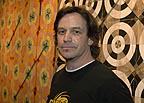April 22, 2008
Two students share Rickert-Ziebold art award
CARBONDALE, Ill. — The two winners in the annual Rickert-Ziebold Trust Award juried art competition at Southern Illinois University Carbondale both presented artistic endeavors designed to make the viewer question his or her beliefs. And there the similarities end.
This year, the $20,000 award is split between Mike McLain of De Soto and Julia Rogers of Philomath, Ore. A jury of 21 School of Art and Design faculty members selected the two from a pool of 14 finalists, themselves chosen from an original group of 24 applicants. An exhibit of all the Rickert-Ziebold competition finalists is open now through Friday, April 25, at the Surplus Gallery in the old Glove Factory at 432 S. Washington Ave. A reception for the winners is set from 5:30 to 8 p.m. on Friday, with an awards ceremony at 6:30 p.m.
McLain offered two groups of paintings, Rogers had an installation piece. McLain, who exhibited a trio of paintings on the floor, challenged viewers to question the definitions of art. He asked, in his artist's statement, whether a painting remains a painting if shown on the floor. Is a sculpture a sculpture if hung on the wall? His questions, he said, arose when he, a sculpture and drawing student, took a painting class.
Rogers, on the other hand, used her space to create a laboratory setting that highlights the question of genetic modification in human beings. Her installation included representations of fetuses in various forms of development – from a few cells in a Petri dish to the ready-to-be-born – in a convincing lab setting. She said her goal was not to express an opinion, but rather to pose questions about the possibilities of genetic engineering and where those possibilities might lead the human race.
Xuhong Shang, associate professor of painting and a member of the Rickert-Ziebold committee, said he believed this year's competition was particularly intense because last year's competition saw a single winner of the entire $20,000 scholarship. In the past, he said, the jury picked four or five winners, reducing the amount of the scholarship for each individual winner. Knowing that as much as $20,000 could be at stake, though, set a high goal.
Shang said another element of the competition he enjoyed is the diversity of exhibits. It can truly be said there are no two alike in the entire exhibit. Shang said that is because the School of Art and Design faculty emphasize that students should find their own voices and their own expressions.
The practical lessons of a scholarship competition like the Rickert-Ziebold – known affectionately as The RZ – are important, too.
"For many students, this is their first juried show," Shang said. "They learn that it is not only what they make for art, but also how they present it."
McLain plans to pursue a graduate degree at Claremont Graduate University in California. He said the scholarship alleviates some of his money concerns as he plans his cross-country move.
"I can put the back seat back in my Jeep, I won't have to worry about sleeping in it now," he joked.
McLain said he began his art studies at John A. Logan College and visited The RZ exhibit with his class and was very impressed. "And now I'm in it!" he said. "The other work in this exhibit is so amazing, it's an honor just to be in this competition."
McLain said he made adjustments to his exhibit at the very last minute. The triptych of paintings on the floor didn't seem to fit his allotted space the way he had them originally, he said, so he shifted them. At the last minute, he felt he should put them back as they were originally intended to be shown.
"I'm glad I did," he said.
Rogers explained that an installation – an artistic exhibit that is meant to last only as long as the exhibit's run – requires considerable work. The art must make a powerful statement that outlasts its temporary status. Unlike a painting or a sculpture that can be brought home and displayed and contemplated, it must be appreciated in its own setting.
"I think (installation art) is the way art is going, though," she said. "It isn't just about a painting, it's about the whole concept."
Rogers worked with latex and silicone with this project – new materials for her as an artist. She said working with them was challenging – particularly because the project took longer than anticipated – but she enjoyed it. She said she also had to hit the books for this exhibit.
"I had to study the way the human body develops as a fetus," she said. "Even though I have a child, I didn't realize that at just a few weeks they already have everything (anatomically) and that it just gets bigger as they grow."
She said proportion is different with fetuses. Her early attempts, she said, looked like "little men" until she observed how a developing fetus has proportionately skinny arms and legs and a large head, for example.
Rogers is considering graduate work at Bowling Green University in Ohio.
The annual Rickert-Ziebold Trust Award commemorates Joseph Rickert, a prominent lawyer and former state senator from Waterloo, who loved the arts. His family established the award in his honor in 1974.
Caption:
2008 Rickert-Ziebold Trust Award – Mike McLain of De Soto, Ill., stands with his multi-piece painting submission for the annual Rickert-Ziebold Trust Award at Southern Illinois University Carbondale. McLain was one of two winners of the annual juried art show scholarship competition. He plans to use his $10,000 award to pursue graduate work in art at Claremont Graduate University in California.
Photo by Russell Bailey
2008 Rickert-Ziebold Trust Award – Julia Rogers, from Philomath, Ore., with her installation art piece, GMH Biotechnologies, an exhibit that asked the viewer to question the possibilities of a future with genetically modified human beings. Rogers was one of two winners of this year's juried art competition. She plans to use her $10,000 award for further study of art.
Photo by Russell Bailey


